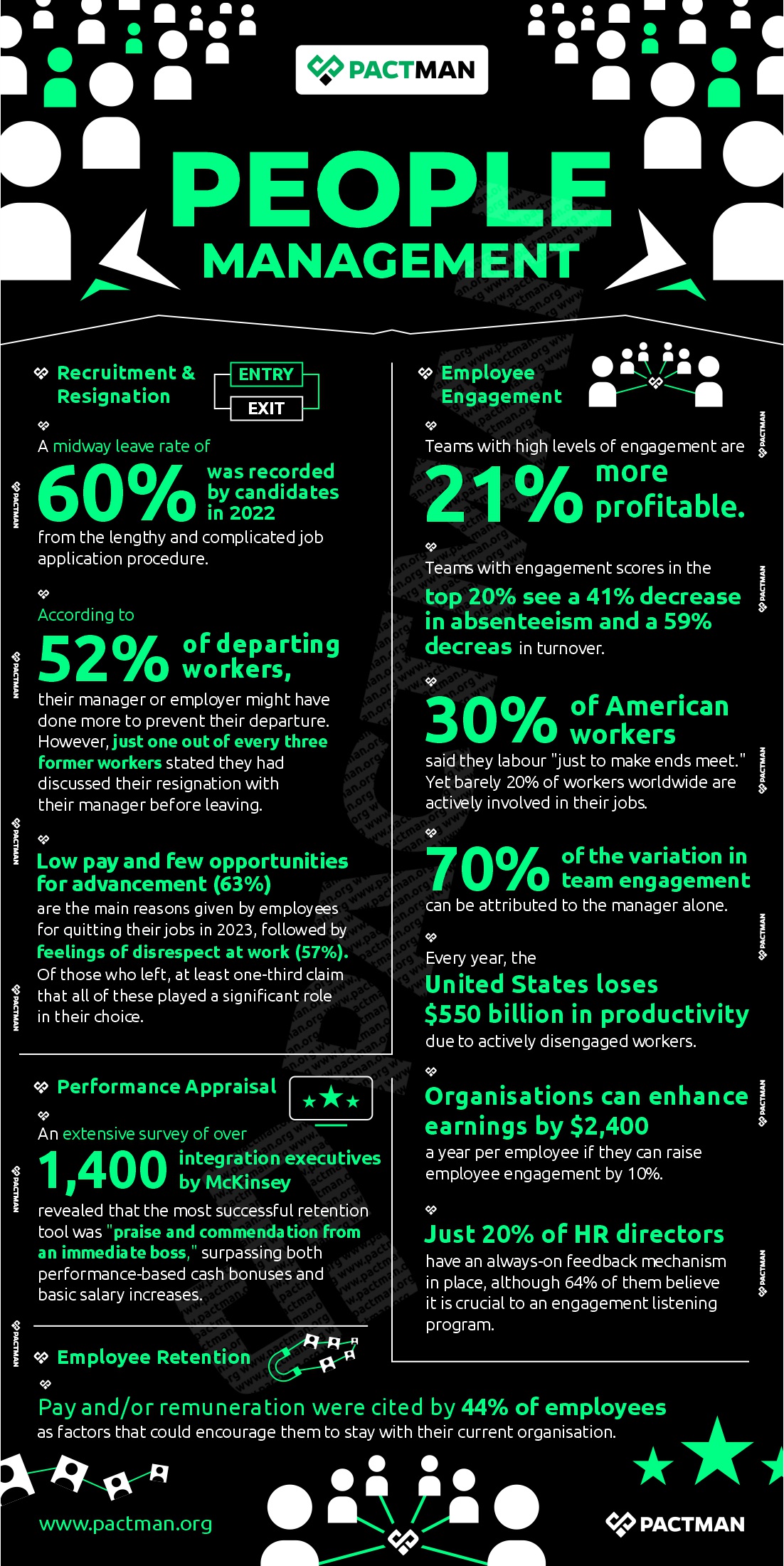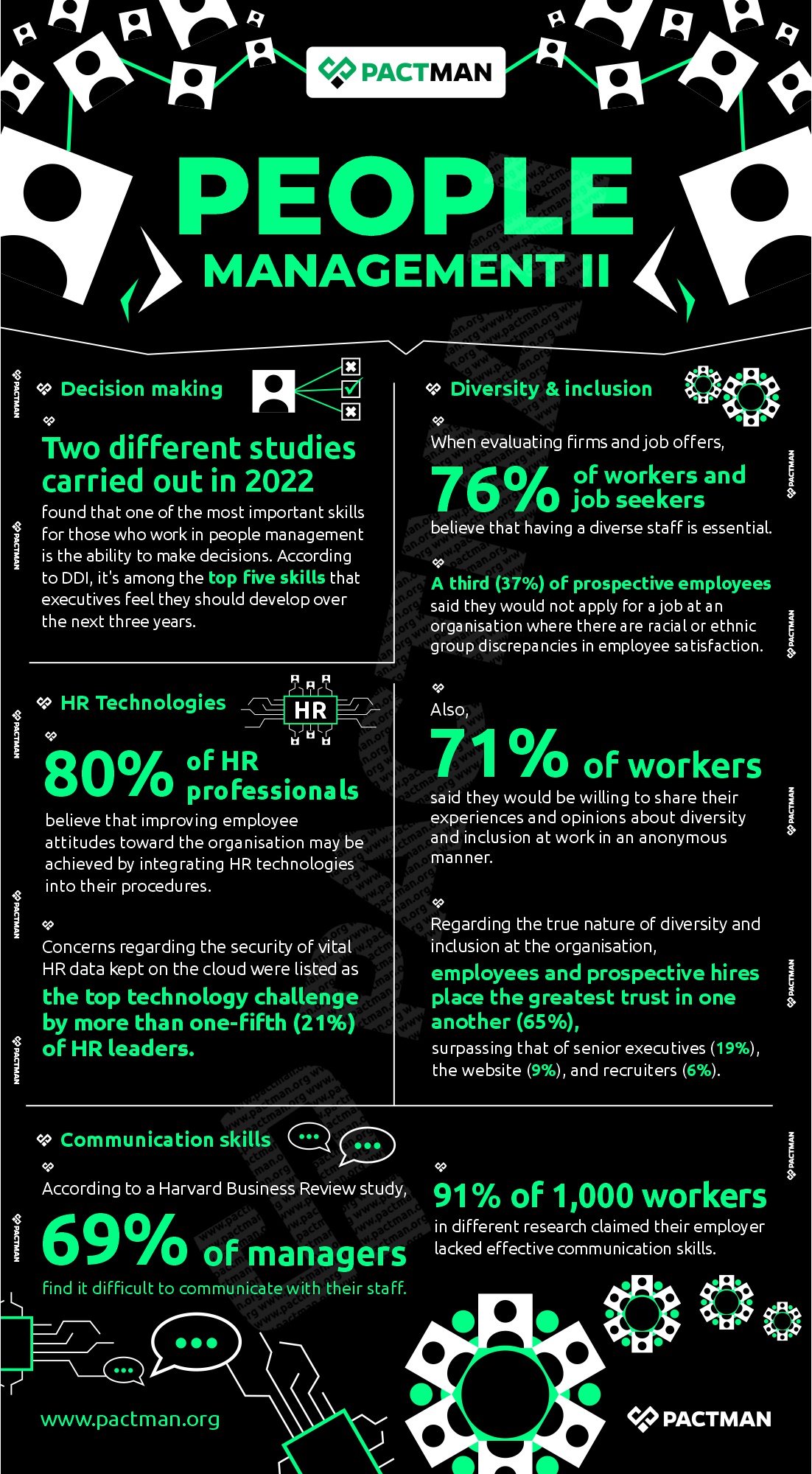I
Introduction
The talents, skills, abilities, and motivations of employees and volunteers are among the most valuable resources in nonprofit organisations. As a result, people management is a fundamental responsibility of nonprofits since a large part of the work is labour-intensive. Strategic human resource management and leadership are fundamental components of people management. Essentially, it entails the administration of individuals and their work to accomplish organisational objectives as managed by managers at all levels, not only HR specialists.

Over time, there have been changes in people management’s theoretical and practical applications. There is a long-standing history of the various facets of internal management, and the administration of individuals and their labour to accomplish organisational objectives. By and large, the definition of people management entails implementing HR practices by managers and ensuring leadership behaviour supports the employees they supervise at work. This is the subject matter that will be considered in this article.
II
The Foundation of People Management
People management encompasses both highly specialised strategies like performance management as well as more broad strategies that are pertinent to managing staff in nonprofit organisations. Managers’ application of HR procedures and their leadership actions have a significant impact on the perception of staff members. Hence, leadership and HRM are essential ideas that are interconnected in the study of people management.

The people who work for an organisation at any level are the foundation of its success. Therefore, it is critical to take good care of these roots to sustain the organisation’s expansion. The need to manage the workforce with care and attention is even greater in the modern, globalised world where teams are bigger, more diverse, and interact more virtually across time zones and international borders.
Human resource management is a crucial and essential component of people management. Its primary goal is to match each employee’s needs and aspirations with the expansion and goals of the organisation. In addition, HRM ensures that the most qualified candidate is hired for a given position. Maximizing the potential of the organisation’s human capital and funds while adjusting it to meet its objectives is the major goal.
III
Critical Statistics on People Management
In this section, we will consider hiring & recruitment statistics that emphasize the need for effective people management.
1. Recruitment & Resignation
A midway leave rate of 60% was recorded by candidates in 2022 from the lengthy and complicated job application procedure. According to 52% of departing workers, their manager or employer might have done more to prevent their departure. However, just one out of every three former workers stated they had discussed their resignation with their manager before leaving.
Low pay and few opportunities for advancement (63%) are the main reasons given by employees for quitting their jobs in 2023, followed by feelings of disrespect at work (57%). Of those who left, at least one-third claim that all of these played a significant role in their choice.
2. Performance Appraisal
An extensive survey of over 1,400 integration executives by McKinsey revealed that the most successful retention tool was “praise and commendation from an immediate boss,” surpassing both performance-based cash bonuses and basic salary increases.

3. Employee Retention
Pay and/or remuneration were cited by 44% of employees as factors that could encourage them to stay with their current organisation.
4. Employee engagement
Teams with high levels of engagement are 21% more profitable. Also, teams with engagement scores in the top 20% see a 41% decrease in absenteeism and a 59% decrease in turnover. 30% of American workers said they labour “just to make ends meet.” Barely 20% of workers worldwide are actively involved in their jobs. In addition, 70% of the variation in team engagement can be attributed to the manager alone.
Every year, the United States loses $550 billion in productivity due to actively disengaged workers. Organisations can enhance earnings by $2,400 a year per employee if they can raise employee engagement by 10%. Just 20% of HR directors have an always-on feedback mechanism in place, even though 64% of them believe it is crucial to an engagement listening program.
5. Decision making
Two different studies carried out in 2022 found that one of the most important skills for those who work in people management is the ability to make decisions. According to DDI, it’s among the top five skills that executives feel they should develop over the next three years.
6. Tech
80% of HR professionals believe that improving employee attitudes toward the organisation may be achieved by integrating HR technologies into their procedures. Conversely, concerns regarding the security of vital HR data kept on the cloud were listed as the top technology challenge by more than one-fifth (21%) of HR leaders.

7. Diversity & inclusion
When evaluating firms and job offers, 76% of workers and job seekers believe that having a diverse staff is essential. A third (37%) of prospective employees said they would not apply for a job at an organisation where there are racial or ethnic group discrepancies in employee satisfaction.
Also, 71% of workers said they would be willing to share their experiences and opinions about diversity and inclusion at work in an anonymous manner. Regarding the true nature of diversity and inclusion at the organisation, employees and prospective hires place the greatest trust in one another (65%), surpassing that of senior executives (19%), the website (9%), and recruiters (6%).
8. Communication skills
According to a Harvard Business Review study, 69% of managers find it difficult to communicate with their staff. In the meantime, 91% of 1,000 workers in different research claimed their employer lacked effective communication skills.
IV
Attributes of People Management
The phrase “people management” constitutes a wide range of soft skills, some of which are illustrated with examples below.

1. Effective communication
The key to managing people effectively is communication. Hence, a nonprofit manager or leader must, above all, be an effective listener. Understanding the needs of people and their issues is facilitated by active listening. Furthermore, there must be no obstacles to communication, such as bias or prejudice. After there is a clear understanding, it is equally crucial to provide appropriate feedback that is exact and unambiguous when it comes to assigning tasks or solving issues.
For instance, rather than berating or scolding an employee for missing a deadline, it is preferable to have a conversation with them and try to understand the reasons behind their inability to provide the required attention at work. In addition to enhancing interpersonal connections, effective communication solves the core of the issue and increases output and efficiency.
2. Problem solving
Oftentimes, leaders and managers face challenges on all fronts; some are anticipated and planned for. However, interpersonal problems could also be the cause of other urgent concerns. Due to differences in nationality, ethnicity, and race, large and diverse teams can bring about personality conflicts or misunderstandings. The issue is made worse by insensitivity to gender, caste, and class.
By and large, to guarantee that these matters are handled with the highest discretion and care, people management skills are required. In addition to requiring strong critical thinking and problem-solving abilities, managers also need to be experts in mediation and conflict resolution, both of which fall under the broader category of people management.
3. Appropriate job distribution
Assigning specific tasks to the right individual is also a crucial step in prudent people management. Greater productivity and timely completion can be ensured by comprehending the technical and other components of the task at hand. This includes assigning to individuals the most appropriate specialisation or competency.
Workplace specialisation is growing, and organisations must have the right vision to guarantee that individual competencies and group objectives are in line.
4. Balanced appreciation and constructive criticism
Also, managers and leaders have a challenging job since they have to ensure that a task is completed on time. This can only be done when everyone in the team is focused on the same goal. However, humans are complicated creatures and several factors tend to influence team management.
For nonprofits, criticism must be constructive. Likewise, there is a need to strike the correct balance between praise and criticism as not everyone can handle criticism well.
For instance, it is preferable to acknowledge a team member for prior accomplishments or personal qualities before pointing out areas for improvement. This will make the argument clear and promote harmony in the workplace. Furthermore, assisting junior colleagues in their development and mentoring is another aspect of people management.
5. Recognising different personality types
It is not sufficient to consider a team member’s area of expertise or specialisation; personality type must also be taken into account. A cohesive team that gets along well is essential for the timely and efficient completion of tasks.
Now more than ever, leaders and managers must comprehend human psychology and the interaction of human behaviour and relationships. This is most especially true for global nonprofits with large and diverse teams that also operate in the virtual space across varying time zones. If not addressed, it can obscure or complicate interpersonal relationships and lead to complications.
For instance, it’s crucial to make sure that every member of a mixed-race team, comprising individuals from various nationalities and ethnicities, possesses a greater level of emotional intelligence. Additionally, a harmonious blend of various personality types—passive and aggressive, extroverts and introverts, etc.—makes up a perfect team. Therefore, sensitive and sound awareness of human behaviour and personality types is precluded for people management.
6. Motivation
Lastly, one of the key components of people management is leading teams and encouraging proactive collaboration. There will always be some team members who fall behind and are general slackers, and there will always be some jobs that members do not want to take on.
Not everyone is as committed to the group’s objectives as the others are. This demands that managers have strong persuasion and motivational skills. Some of such include periodic evaluation and recognition, off-site competitions and recreational activities, inspirational talks and workshops, and awarding and appropriately compensating employees.
For instance, a leader may institute the Employee of the Month or Year award, or the management of the organisation may support motivational workshops. This can result in increased output and worker happiness.
V
How to Improve People Management Skills Within a Nonprofit
While some individuals are naturally skilled in managing people, others must learn the traits. As we all know, learning is a never-ending process. It takes deliberate effort to develop and improve people management skills. In this section, we will consider how nonprofit leaders can improve their people management skills.

1. Clarify your nonprofit Goals
A manager or leader should be clear about the plan and procedure for achieving the organisation’s goals and objectives. Not clarifying these goals can result in confusion among staff members, thereby, defeating the purpose. To begin with, demand input and suggestions from team members, employees and superiors to stay focused and on the course. This ensures that no one loses sight of the objective.
2. Improve Interpersonal Skills
Secondly, managing people involves dealing with their diverse personalities, emotions, and attitudes. Prejudices and stereotypes are baggage that each individual carries with them. As earlier stated, it takes skill to manage people. Therefore, being kind and amiable is crucial.
Employees tend to interact with managers who are laid back and approachable. They also become more open to advice and criticism as well as to problem-solving assistance. Gain an acute awareness of others, make an effort to connect with them, hear their viewpoint before expressing your own, and have an affable and upbeat attitude at all times. This has a significant positive impact on improving people management and interpersonal skills.
3. Boost Your Communication skills
In addition, improve your communication skills; they are the cornerstone of successful and productive people management. Active listening is the most important skill; pay close attention to what others are saying. Recognise the complete message being transmitted, including any indications being sent by paralinguistic cues.
Also, focusing on the message you are trying to get out is equally vital. It needs to be clear and succinct. If there are any obstacles in the way of communication, try to eliminate them. Interpersonal problems may include gender barriers. Seek input regularly. Also, constructive feedback can aid in communication improvement.
4. Understand Emotional Intelligence
All soft skills, especially those related to people management, are built on the foundation of emotional intelligence. This is the capacity to comprehend people without bias or prejudice, to put oneself in their shoes, and to understand them. Without a doubt, compassion and empathy will boost emotional intelligence and improve workplace relationships. The role of a nonprofit leader is to foster a supportive environment and workplace where team members feel comfortable.
5. Increase Your Flexibility and Adaptability
Rarely does everything go according to plan. Although one may have a backup plan or strategy in place for such situations, it’s crucial to be adaptable and adjust to new situations as they arise. In addition, one must develop the ability to be flexible and open to other approaches to problems rather than being inflexible and unyielding. The advantage is everyone tends to gain knowledge from this experience. In such cases, you can ask the team for their thoughts and make sure they are with you. Never forget that a manager or leader is only as good as their team. Become an integral member of the team rather than lead from the outside.
6. Improve Your Ability to Think Critically and Solve Problems
Lastly, employees or team members will look to you for answers to a variety of issues. Therefore, you must develop your analytical and problem-solving abilities. This will result in improved personnel management.
Also, outstanding ideas demand outstanding answers. A manager’s difficulties are exacerbated by challenges. Hence, maintaining composure, tolerance, and patience is essential. When faced with a problem, consider your options carefully and contemplate a quick solution.
Conclusion
In summary, people management has an impact on almost every aspect of an organisation, as people are the driving force behind its operation. Also, the workplace culture that emerges from people management programs has the power to influence an organisation’s reputation for years to come.
The ability to manage people encompasses all aspects, including finding and developing the proper skills while nurturing and improving them. Likewise, it entails coordinating organisational objectives. The secret to happy employees is effective people management. Hence, increased productivity is the result of a favourable work environment where employees are motivated and pleased.
Now more than ever, nonprofits need to invest in people management methods. Many organisations encourage their staff members to seek advanced degrees or talents for which they are prepared to cover the cost. This investment will pay off handsomely in the form of increased work and productivity.
If this article resonates with you, we welcome your thoughts, suggestions, and questions.



One Response